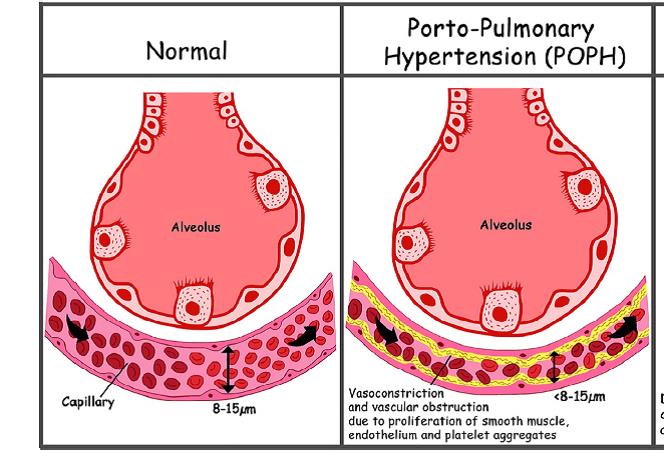Pulmonary hypertension (known as porto-pulmonary: HPoP) appears in approximately 2% of patients who develop portal hypertension: this lung vascular damage could be due to the passage through the pulmonary circulation of toxic substances of splanchnic origin (perhaps associated residual activity of pancreatic enzymes) beyond the 'liver' filter. These substances would lead to specific abnormal pulmonary angiogenesis and the progressive development of intimal fibrosis, plexiform lesions and thrombosis (organized and recanalized) at the level of the distal pulmonary arteries. Cases of pulmonary hypertension due to a congenital porto-systemic shunt and without portal hypertension have been described. HPoP diagnostic criteria are a mean PAP > 25 mmHg at rest with high pulmonary resistance (> 240 dynes.s.cm5, or > 3 Wood units, on the contrary of the PH linked to a hyperdynamic circulation) and a low capillary pressure (on the contrary of a situation of hypervolemia). The HPoP is considered as moderate when the mean PAP is > 35 mmHg and severe if it is > 45 mmHg.

The symptoms are: the onset of exertional dyspnea, palpitations, syncope. The diagnosis is made by transthoracic echocardiography (Doppler) which must be regularly done in any patient with portal hypertension or portosystemic congenital shunts. The proposed treatments are prostacyclin, bosentan (but risk of liver toxicity), sildenafil. The presence of a HPoP is not an indication of liver transplantation as the perioperative mortality is significant in these cases.
Anesthetic implications:
the anesthetic management for a child suffering from porto-pulmonary hypertension involves:
- checking liver function and hemostasis (low blood platelets count ?)
- the use of an intraoperative esophageal echocardiography (risk/benefit evaluation when esophageal varicosities are present), or a direct measurement of pulmonary arterial pressures (Swan-Ganz catheter) to make the early diagnosis of an acute pulmonary hypertension crisis
References :
- Chabot F, Gomez E, Boyer L, Kheir A, Le Pavec J, Sitbon O, Herve P.
Hypertension portopulmonaire.
Rev Mal Resp 2006 ; 23 : 629-41. - Ersch J, Bäzinger O, Braegger C, Arbenz U, Stallmach T.
An infant with pulmonary hypertension due to congenital porto-caval shunt.
Eur J Pediatr 2002; 161:660-2. - Lee WS, Wong SY, Ivy D, Sokol RJ.
Hepatopulmonary syndrome and portopulmonary hypertension in children: recent advances in diagnosis and management.
J Pediatr 2018; 196; e14-21.
Updated: May 2018